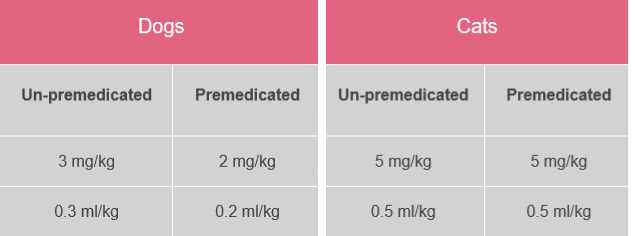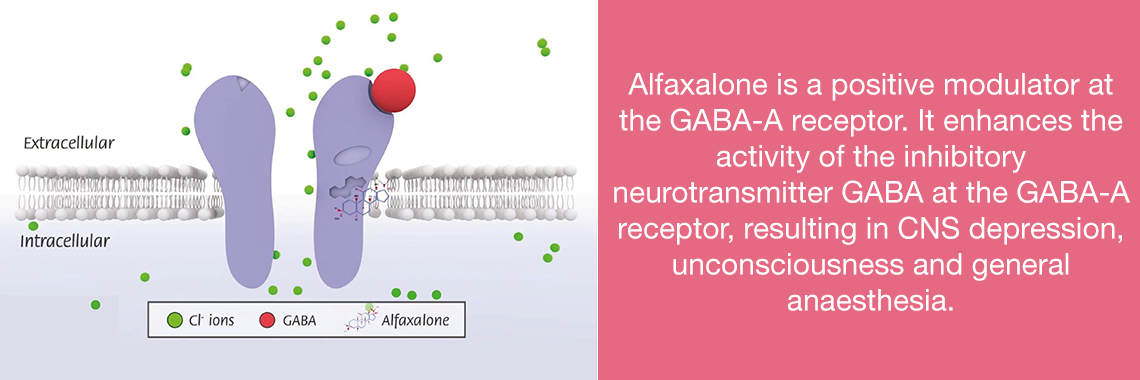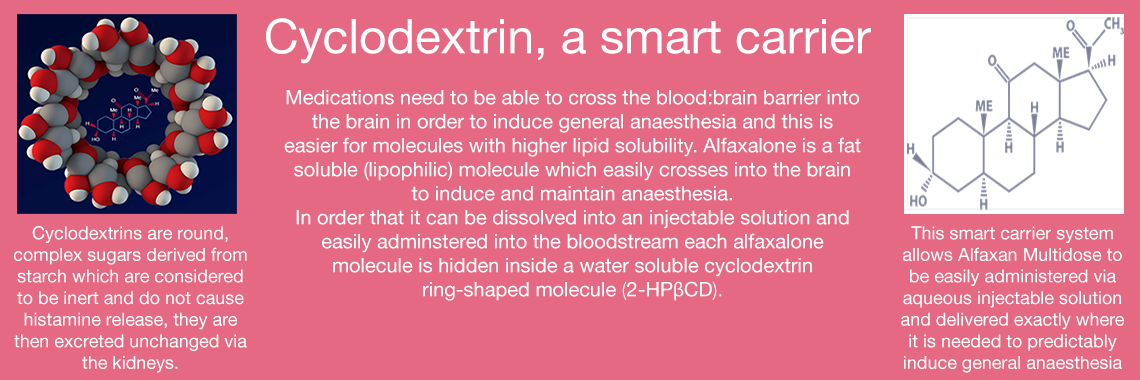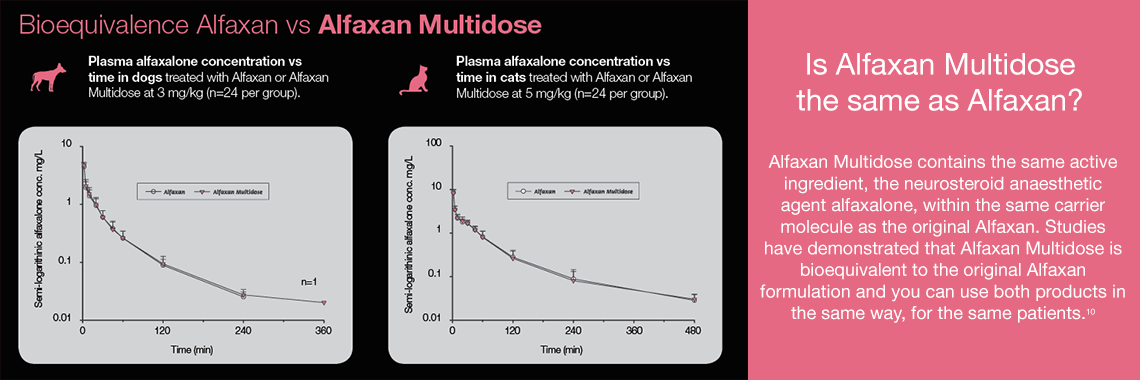
Alfaxan Multidose is the only veterinary licensed neuro-steroid anaesthetic agent and its unique mechanism of action delivers repeatable, reliable and smooth anaesthetic induction23,24.
Alfaxan Multidose is a 10 mg/ml (1%) clear, aqueous solution containing the neuroactive steroid molecule alfaxalone, licensed for:
Reasons to choose Alfaxan Multidose:
Alfaxan Multidose has been developed for the specific needs of your veterinary patients, with its wide safety margin and excellent cardiovascular stability, you can use Alfaxan Multidose with confidence in all your patients from ASA I-V. Alfaxan Multidose provides additional flexibility and versatility.
Alfaxan Multidose is versatile, suitable for all types of patient, including prior to canine c-sections6,7,14 and can be used for both induction and maintenance in dogs and cats. It is also licensed for induction of anaesthesia in pet rabbits30.

Alfaxan Multidose provides all of the benefits of the original Alfaxan formulation but with the additional benefit of convenience. Alfaxan Multidose has a 28 day broached vial shelf life and comes in both 10 ml and 20 ml vial sizes for ultimate flexibility.
 Acute overdose studies have shown that animals who were administered multiples of the recommended induction dose of Alfaxan multidose recovered with no residual adverse effects.18,19
Acute overdose studies have shown that animals who were administered multiples of the recommended induction dose of Alfaxan multidose recovered with no residual adverse effects.18,19
Alfaxan Multidose provides you with confidence in situations where your patient requires repeated general anaesthetics within a short time period.25

A repeated overdose study in dogs and cats anaesthetised animals with 5x the recommended induction dose of Alfaxan multidose, 3 times over 5 days and showed minimal adverse effects.25
This is a strong advantage over some other classes of induction agent where repeated anaesthetics can cause adverse effects, particularly for cats.
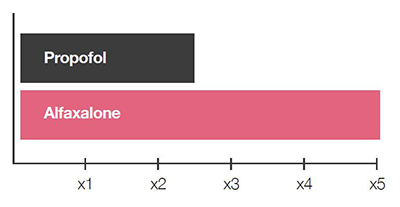
Alfaxan multidose results in minimal disruption to cardiorespiratory parameters18,19, and is less likely to cause apnoea than other agents.4,13
One study showed that apnoea was seen following only a 2.5x overdose of propofol, whilst a 5x overdose of Alfaxan multidose was required to cause the same level of apnoea.
Alfaxalone is rapidly and completely metabolised9 so that animals experience a smooth and rapid recovery, appear clear-headed and display normal behaviour shortly after recovery.10
Alfaxalone is a type of neurosteroid which has a similar molecular structure to progesterone (although does not act at the same receptors) and as a result alfaxalone is rapidly and predictably eliminated along established metabolic pathways.
Recovery remains the highest risk phase of anaesthesia, therefore you don’t want your induction agent to still be acting during your patient’s recovery as this could cause complications and highlights the important benefit of this rapid, predictable metabolism.
Remember the importance of using good premedication and carefully maintaining body temperature to ensure the best possible recovery.
With Alfaxan Multidose you are likely to see:

Alfaxan multidose provides smooth induction, intubation and transition to maintenance and rapid onset of action.
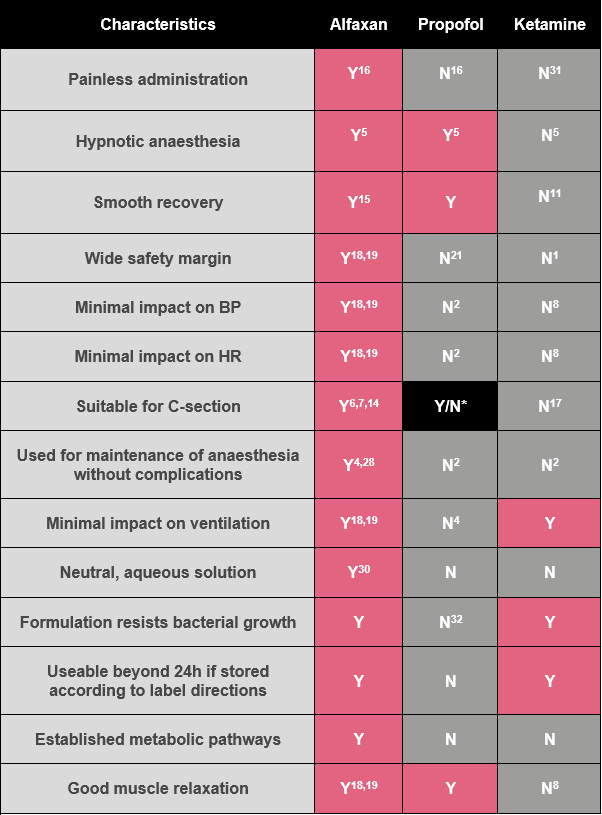
*Relevant SPC
General anaesthesia is a common procedure in veterinary practice, however, it should never be considered entirely without risk. It can be a stressful process both for patients and for your veterinary team. Anaesthesia doesn’t have to be stressful and we should aim to ensure that the anaesthetic experience for patients is as positive as possible. This can be achieved by using a reliable, predictable anaesthetic agent such as Alfaxan Multidose and using protocols that you are confident with and suit the needs of each individual patient.
Although uncommon, death is an anaesthetic risk. The level of risk varies according to species, procedure and health status prior to anaesthesia3. The risk is lower in humans than in veterinary species which may be due to differences in many aspects including staff training and monitoring levels.
In our common small animal species the anaesthetic risk is highest in rabbits, especially in sick rabbits3. Is this because that there are only a few licensed medications to treat rabbits? Or is it that we are generally less familiar with this species than with dogs and cats? Or is our monitoring different or are there other reasons?
It is advised that all patients, including rabbits, have an IV catheter placed prior to anaesthesia and an airway maintained throughout. The AVA have produced guidelines to support safer anaesthesia and these are available on the Dechra website
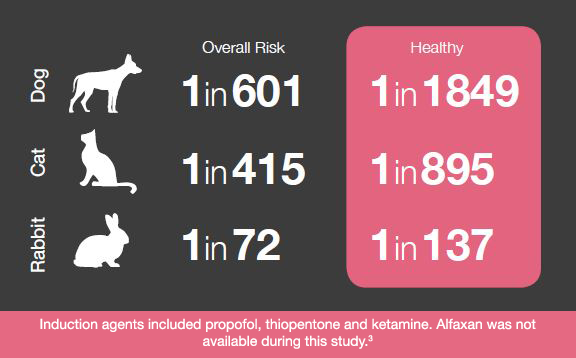
At Dechra we are passionate about anaesthesia and pain management and are working hard to reduce the risk of anaesthesia to our veterinary patients and develop the anaesthetic confidence of veterinary professionals. All of our anaesthesia products, including Alfaxan Multidose, are supported by the Dechra technical team. We provide both product support and education via the Dechra Academy which is free to use.
Alfaxan Multidose provides additional benefits thanks to the addition of a preservative system. This preservative system includes; chlorocresol, benzethonium chloride and ethanol (NOT benzyl alcohol) which allows a 28 day broached vial shelf-life, giving you all of the benefits of Alfaxan with the added convenience of a multi-dose formulation. All of the components of the preservative system are used extensively in both human and veterinary pharmaceuticals and are well known. Alfaxan Multidose has a low available concentration of chlorocresol - most is hidden inside the cyclodextrin rings with the alfaxalone molecule and the pH of the solution remains near neutral.
There is also additional flexibility provided through two different vial sizes; 10 ml and 20 ml allowing you to choose the best fit for your clinic.
Supporting you
Dechra provides you with an extensive range of resources to support you when using Alfaxan Multidose. We are passionate about best practice anaesthesia and have a range of materials to support you in developing your anaesthetic practice and increasing confidence in your team. We work closely with the AVA and have provided support for their recently published ‘Safer Anaesthesia Guidelines’ around the world.
When every case is unique, it calls for a solution that is uniquely versatile. Alfaxan Multidose forms part of Dechra’s comprehensive range of products placed to meet the anaesthetic and analgesic requirements of your patients. We can support you to tailor your protocols to the needs of every unique patient and provide you with an extensive range of products to meet your requirements.
- Arnbjerg, J. (1979) ‘Clinical manifestations of overdose of ketamine-xylazine in the cat’ Nord. Vet. Med. 31(4); pp. 155-161
- Berry, S.H. (2017) ‘Injectable Anaesthetics’ In: Grimm, K.A; et.al; Veterinary Anaesthesia and Analgesia, Wiley and Sons, Ltd; UK
- Brodbelt, D; et.al. (2008) ‘The risk of death: the confidential enquiry into perioperative small animal fatalities’ VAA 35(5); pp. 365-373
- Campagna, I; et al. (2014) ‘Comparison of the effects of propofol or alfaxalone for anaesthesetic induction and maintenance on respiration in cats’.VAA 42(5); pp. 484-92
- Clark, K.W; Hall, L.W. and Trim, C.M. (2014) ‘Veterinary Anaesthesia’ 11th Ed. Saunders/Elsevier; pp. 694
- Doebeli, A; et.al. (2013) ‘Apgar score after induction of anaesthesia for canine caesarean section with alfaxalone versus propofol’ Theriogenology 80; pp. 850-854
- Doebeli, A; et.al. (2013) ‘Induction of anaesthesia for canine caesarean section with alfaxalone’ Reproductive Biology 135; pp. 22-64
- Duke-Novakovski, T. et.al. eds; (2016) BSAVA Manual of Canine and Feline Anaesthesia and Analgesia, 3rd Edition, Quedgeley
- Ferre, P.J; et.al. ‘Plasma pharmacokinetics of alfaxalone in dogs after an intravenous bolus of Alfaxan-CD RTU’ VAA 33(4), pp. 29-36
- Freedom of Information Summary, NADA 141-342, Jurox Pty Limited
- Hellebrekers, L.J; et.al. (1998) ‘Clinical efficacy and safety of propofol or ketamine anaesthesia in dogs premedicated with medetomidine’ Vet. Rec. 142(2); pp. 631-634
- Jurox, (2005) Jurox Pharmacovigilance report JX9604-SR004
- Keates, H; et al. (2012) ‘Effect of intravenous dose escalation with alfaxalone and propofol on occurrence of apnoea in the dog.’ Research in Veterinary Science 93; pp. 904-906
- Metcalfe, S; et.al. (2008) ‘A multi-centre clinical trial evaluating the efficacy and safety of Alfaxan administered to bitches for induction of anaesthesia prior to caesarean section’ In: 33rd World Small Animal Congress. Dublin, Ireland: WSAVA/FECAVA
- Mathis, A; et.al. ‘Comparison of quality of recovery from anaesthesia in cats induced with propofol of alfaxalone’ VAA 39(3); pp. 282-290
- Michou,J; et.al. (2012) ‘Comparison of pain on injection during induction of anaesthesia with alfaxalone and two formulations of propofol in dogs’ VAA 39(3); pp. 275-281
- Moon-Massat, P.F. and Hrb, H.N. (2002) ‘Perioperative factors associated with puppy vigor after delivery by caesarean section’ J.Am.Animal Hospital Assoc. 38(1); pp. 90-96
- Muir, W; et.al. (2009) ‘The cardiorespiratory and anaesthetic effects of clinical and supraclinical doses of alfaxalone in cats.’ VAA 36(1); pp. 42-54
- Muir, W; et.al. (2008) ‘Cardiorespiratory and anaesthetic effects of clinical and supraclinical doses of alfaxalone in dogs’ VAA 35(6); pp. 451-462
- O’Hagan; et.al. (2012) ‘Clinical evaluation of alfaxalone as an anaesthetic induction agent in dogs less than 12 weeks of age’ Australian Veterinary Journal 90(9); pp. 346-350
- O’Hagan; et.al. (2012) ‘Clinical evaluation of alfaxalone as an anesthetic induction agent in kittens less than 12 weeks of age’ Australian Veterinary Journal 90(10); pp. 395-401
- Pasloske, K; et al’ (2009) ‘Plasma pharmacokinetics of alfaxalone in both premedicated and unpremedicated Greyhound dogs after single, intravenous administration of Alfaxan at a clinical dose.’ Journal of Veterinary Pharmacology and Therapeutics, 32; pp. 510-513
- Pasloske, K; et.al. (2007) ‘A multicentre clinical trial evaluating the efficacy and safety of Alfaxan administered to cats for induction and maintenance of anaesthesia’ BSAVA Congress 2007, Birmingham, UK.
- Pasloske, K; et.al. (2005) ‘A multicentre clinical trial evaluating the efficacy and safety of Alfaxan-RTU administered to dogs for induction and maintenance of anaesthesia.’ BSAVA Congress 2005, Birmingham, UK.
- Pasloske, K. and T. Whittem (2004) ‘A target animal safety study in cats after administration of Alfaxan -CD RTU as single, repeated injections on days 0, 2, and 5 at dosages of 5, 15 or 25 mg/kg’ JX9604.07-H004 Jurox Pty Limited
- Psatha, E; et.al. (2011) ‘Clinical efficacy and cardiorespiratory effects of alfaxalone, or diazepam/fentanyl for induction of anaesthesia in dogs that are a poor anaesthetic risk’ VAA 38; pp. 24-36
- Schnell, M; et.al. (2004) ‘Margin of safety of the anaesthetic agent Alfaxan-CD RTU at dogs 0, 1, 3, 5x the intravenous dose of 2 mg/kg. ACVIM, Minnesota
- Suaraz, M.A; et.al. (2012) ‘Comparison of alfaxalone and propofol adminstered as total intravenous anaesthesia for ovariohysterectomy in dogs’ VAA 39(3); pp. 236-244
- Sullivan, K.R. (2010) ‘ Analgesics, tranquilisers and sedatives’ In: Cardiac Intensive Care, 2nd Edition, Elsevier, pp. 504-515
- Summary of Product Characteristics - Alfaxan Multidose, Dechra Veterinary Products EU
- Summary of Product Characteristics - Ketaset, Zoetis, UK
- Tessler, M; et.al. (1992) ‘Growth curves of Staphylococcus aureus, Candida albicans and Moraxella osloensis in propofol and other media’ Canadian Journal of Anaesthesia 39(5); pp. 509-511
- Whittem, T. and K. Pasloske. (2004) ‘Eight day target animal safety study of intravenous Alfaxan CD RTU in dogs administered every other day’ RD9604.03-H005 Jurox Pty Limited


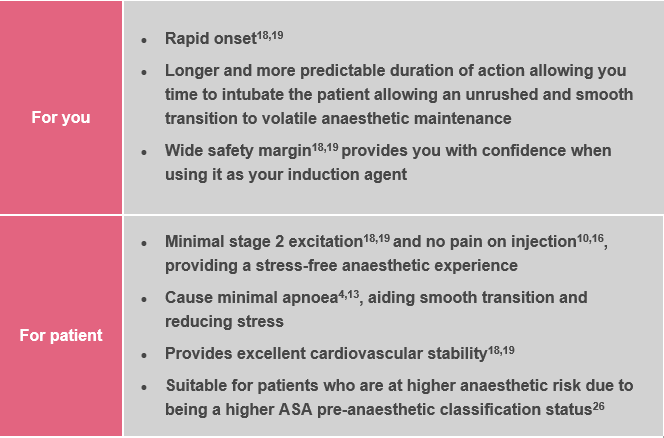

 Administer Alfaxan Multidose slowly, to effect, over 60 seconds.
Administer Alfaxan Multidose slowly, to effect, over 60 seconds. It is recommended that Alfaxan Multidose is administered in ¼ dose increments every 15 seconds, assessing anaesthetic depth after each ¼ dose
It is recommended that Alfaxan Multidose is administered in ¼ dose increments every 15 seconds, assessing anaesthetic depth after each ¼ dose